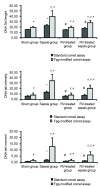Resveratrol Protects Sepsis-Induced Oxidative DNA Damage in Liver and Kidney of Rats
- PMID: 27994910
- PMCID: PMC5156458
- DOI: 10.5152/balkanmedj.2016.15516
Resveratrol Protects Sepsis-Induced Oxidative DNA Damage in Liver and Kidney of Rats
Abstract
Background: The increases of free radicals have been proposed to be involved in the pathogenesis of sepsis, which leads to multiple-organ dysfunction syndromes. The uses of antioxidants as a complementary tool in the medical care of oxidative stress-related diseases have attracted attention of researchers. Resveratrol (RV) has suggested being antioxidant, anti-proliferative, and anti-inflammatory effects in various experimental models and clinical settings.
Aims: This study was undertaken to evaluate the protective effects of RV on oxidative DNA damage induced by sepsis in the liver and kidney tissues of Wistar albino rats.
Study design: Animal experimentation.
Methods: Four experimental groups consisting of eight animals for each was created using a total of thirty-two male Wistar albino rats. Sham group was given 0.5 mL of saline intra-peritoneal (ip) only following laparatomy. Sepsis group was given 0.5 mL saline ip only following the induction of sepsis. RV-treated group was given a dose of 100 mg/kg ip RV in 0.5 mL saline following laparatomy. RV-treated sepsis group was given 100 mg/kg ip RV in 0.5 mL saline following the induction of sepsis. A model of sepsis was created by cecal ligation and puncture technique. In the liver and kidney tissues, oxidative stress parameters (malondialdehyde (MDA), reduced glutathione (GSH), superoxide dismutase (SOD), glutathione peroxidase (GPX)) and a proinflammatory cytokine (tumor necrosis factor alpha (TNF-alpha)), were evaluated spectrophotometrically and DNA damage was determined by the alkaline single cell gel electrophoresis (comet assay) technique using formamidopyrimidine DNA glycosylase protein.
Results: In the RV-treated sepsis group, the levels of MDA and TNF-alpha were lower and GSH levels, SOD and GPX activities were higher than in the septic rats (p<0.05). RV treatment significantly reduced the sepsis-induced oxidative DNA damage in the liver and kidney cells (p<0.05).
Conclusion: It is suggested that RV treatment might reduce the sepsis-induced oxidative DNA damages in sepsis-related diseases; however, there is a need for more studies to clear up the protective mechanisms of RV against sepsis.
Keywords: DNA damage; Resveratrol; alkaline single cell gel electrophoresis; oxidative stress; sepsis; tumor necrosis factor alpha.
Conflict of interest statement
No conflict of interests was declared by the authors.
Figures



Similar articles
-
Modulating effects of pycnogenol® on oxidative stress and DNA damage induced by sepsis in rats.Phytother Res. 2014 Nov;28(11):1692-700. doi: 10.1002/ptr.5184. Epub 2014 Jun 11. Phytother Res. 2014. PMID: 24919414
-
Does rosmarinic acid treatment have protective role against sepsis-induced oxidative damage in Wistar Albino rats?Hum Exp Toxicol. 2016 Aug;35(8):877-86. doi: 10.1177/0960327115607971. Epub 2015 Oct 1. Hum Exp Toxicol. 2016. PMID: 26429925
-
The protective role of ferulic acid on sepsis-induced oxidative damage in Wistar albino rats.Environ Toxicol Pharmacol. 2014 Nov;38(3):774-82. doi: 10.1016/j.etap.2014.08.018. Epub 2014 Sep 16. Environ Toxicol Pharmacol. 2014. PMID: 25305738
-
Health Effects of Resveratrol: Results from Human Intervention Trials.Nutrients. 2018 Dec 3;10(12):1892. doi: 10.3390/nu10121892. Nutrients. 2018. PMID: 30513922 Free PMC article. Review.
-
Resveratrol: Potential Application in Sepsis.Front Pharmacol. 2022 Feb 9;13:821358. doi: 10.3389/fphar.2022.821358. eCollection 2022. Front Pharmacol. 2022. PMID: 35222035 Free PMC article. Review.
Cited by
-
Effect of Celecoxib and Infliximab against Multiple Organ Damage Induced by Sepsis in Rats: A Comparative Study.Biomedicines. 2022 Jul 6;10(7):1613. doi: 10.3390/biomedicines10071613. Biomedicines. 2022. PMID: 35884918 Free PMC article.
-
[Predictive values of serum 8-hydroxydeoxyguanosine on disease progression and prognosis of patients with sepsis].Zhonghua Shao Shang Yu Chuang Mian Xiu Fu Za Zhi. 2022 Mar 20;38(3):207-214. doi: 10.3760/cma.j.cn501120-20210910-00311. Zhonghua Shao Shang Yu Chuang Mian Xiu Fu Za Zhi. 2022. PMID: 35325965 Free PMC article. Chinese.
-
Resveratrol attenuates arsenic-induced cognitive deficits via modulation of Estrogen-NMDAR-BDNF signalling pathway in female mouse hippocampus.Psychopharmacology (Berl). 2021 Sep;238(9):2485-2502. doi: 10.1007/s00213-021-05871-2. Epub 2021 May 28. Psychopharmacology (Berl). 2021. PMID: 34050381
-
Multidimensional biological activities of resveratrol and its prospects and challenges in the health field.Front Nutr. 2024 Jun 12;11:1408651. doi: 10.3389/fnut.2024.1408651. eCollection 2024. Front Nutr. 2024. PMID: 38933889 Free PMC article. Review.
-
Assessing the potential of nifedipine and resveratrol to enhance ovarian viability in conjunction with detorsion treatment: A rat ovarian torsion model study.Turk J Obstet Gynecol. 2025 Jun 4;22(2):154-162. doi: 10.4274/tjod.galenos.2025.30161. Turk J Obstet Gynecol. 2025. PMID: 40462448 Free PMC article.
References
-
- Andrades M, Ritter C, Moreira JDF, Dal-Pizzol F. Oxidative parameters differences during non-lethal and lethal sepsis development. J Surg Res. 2005;125:68–72. https://doi.org/10.1016/j.jss.2004.11.008. - DOI - PubMed
-
- Andrades ME, Ritter C, Dal-Pizzol F. The role of free radicals in sepsis development. Front Biosci. 2009;1:277–87. - PubMed
-
- Bishayee A, Barnes KF, Bhatia D, Darvesh AS, Carroll RT. Resveratrol suppresses oxidative stress and inflammatory response in diethylnitrosamine-initiated rat hepatocarcinogenesis. Cancer Prev Res (Phila) 2010;3:753–63. https://doi.org/10.1158/1940-6207.CAPR-09-0171. - DOI - PubMed
-
- Aggarwal BB, Bhardwaj A, Aggarwal RS, Seeram NP, Shishoda S, Takada Y. Role of resveratrol in prevention and therapy of cancer: preclinical and clinical studies. Anticancer Res. 2004;24:2783–840. - PubMed
-
- Eybl V, Kotyzová D, Cerná P, Koutensky J. Effect of melatonin, curcumin, quercetin, and resveratrol on acute ferric nitrilotriacetate (Fe-NTA)-induced renal oxidative damage in rats. Hum Exp Toxicol. 2008;27:347–53. https://doi.org/10.1177/0960327108094508. - DOI - PubMed
LinkOut - more resources
Full Text Sources
Other Literature Sources
